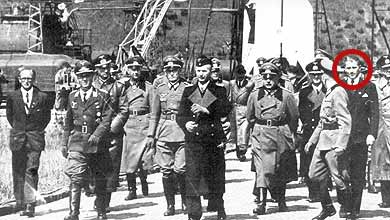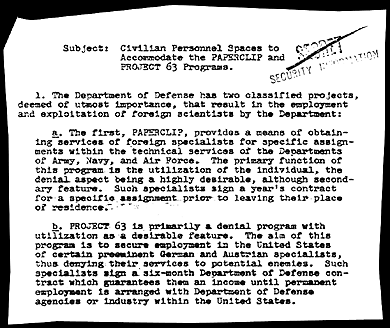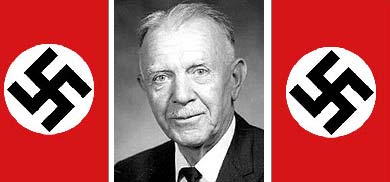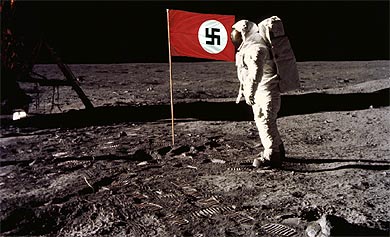La alianza del Pentágono con los nazis «Operación Paperclip»: de los V2 a la Luna por Red Voltaire Al final de la Segunda Guerra Mundial el estado mayor de los Estados Unidos inicia la operación Paperclip a espaldas del presidente Roosevelt. En algunos años, cerca de 1 500 científicos nazis son sacados de Alemania y reclutados para trabajar contra la URSS comunista. Realizan investigaciones principalmente sobre armas químicas, el uso de psicotrópicos en la tortura y la conquista del espacio. Lejos de situarlos en puestos subalternos el Pentágono les confía la dirección de estos programas en los que estampan su sello ideológico. |
|
| Apenas terminada la Segunda Guera Mundial en el teatro de operaciones, se inicia la rivalidad entre los Estados Unidos y la URSS. La prioridad de ambos pasa a ser el rápido saqueo del enemigo vencido: el Tercer Reich de Adolf Hitler. Así, el conocimiento tecnológico desarrollado por los científicos alemanes despierta la codicia aunque haya sido fruto de la explotación de una mano de obra en cautiverio en los campos de concentración. Una parte del estado mayor de los Estados Unidos, sacudida por lo que descubren sus hombres en Dachau, Auschwitz, Dora, ordena recoger la mayor cantidad posible de pruebas con vistas a un proceso de los dirigentes nazis. Por el contrario, otros oficiales del estado mayor consideran que estos criminales son un personal insustituible que conviene poner al servicio del poderío de los Estados Unidos, de modo que el Pentágono pone en marcha una operación para recuperar a los científicos alemanes que hayan trabajado para el Tercer Reich nazi de Adolf Hitler. Llamada «Operación Paperclip» (Operación clips), se le confía a la Joint Intelligence Objectives Agency (JIOA) [1], que entonces agrupa a todos los servicios de inteligencia militar de los Estados Unidos. Como explicará más tarde su director, Bosquet Wev, «el gobierno se preocupaba por “tonterías” −como los expedientes de los nazis− en lugar de priorizar “el interés de los Estados Unidos, de modo que malgastaba inútilmente sus fuerzas queriendo golpear al monstruo nazi muerto”» [2]. La operación se enfrenta a una gran resistencia proveniente al mismo tiempo de dirigentes políticos y en el estado mayor. La posición del presidente Franklin Delano Roosevelt es clara: rechaza el conceder privilegios a los oficiales de las SS y a los miembros del ministerio alemán de Relaciones Exteriores al ser interrogado sobre el asunto por William Donovan, jefe de la OSS. Entre las personas así reclutadas por la OSS «algunos tendrán que ser definitivamente juzgados por crímenes de guerra o al menos detenidos por haber participado de forma activa en las actividades nazis», argumenta. Pasando por encima de la orden presidencial, la JIOA toma la decisión de falsificar expedientes militares de los científicos alemanes que se propone sacar con destino hacia los Estados Unidos [3]. Los científicos más codiciados en lo inmediato son los que han constituido la amenaza más fuerte para los Aliados, es decir, los que han concebido los temibles misiles V2, (cohetes supersónicos) en cuya vanguardia está el nazi Wernher von Braun. Con sólo 32 años en 1945, se trata de uno de los más brillantes ingenieros de la época. Desde la década de 1930 trabaja con Hermann Oberth, padre del cohete alemán. Pasa a formar parte de las SS y del comando personal del jefe de la organización, Heinrich Himmler, antes de obtener el grado de comandante. Durante la guerra trabaja en el centro de Peenemünde en el proyecto de los cohetes V2, construidos en la fábrica Mittelwerk por personal procedente del campo de concentración de Dora.  El mayor de las SS Wernher von Braun en 1943 (círculo rojo). Presentación a los dignatarios nazis del centro de investigación Peenemünde donde fue concebida la «guerra de las galaxias» y realizados los cohetes V2 nazis. Von Braun se convirtió posteriormente en director de la NASA estadounidense. Tras la victoria de los Aliados, es internado por un tiempo en Garmisch por el equipo del coronel norteamericano Holger Toftoy, quien alberga un proyecto descabellado: reiniciar en la base de Fort Bliss, en los Estados Unidos, el programa coheteril en el que trabajaba von Braun, a quien le encarga además convencer a sus antiguos colegas para unirse en la aventura. La tarea no es muy difícil: en su mayoría, los científicos corren el riesgo, si se quedan en Europa, de ser conducidos ante un tribunal por «complicidad en crímenes de guerra». Paralelamente, uno de los directores de la JIOA, E.W. Gruhn, se encarga de hacer una lista de científicos alemanes y austriacos de los más calificados para que sean reclutados y trabajen para el gobierno de los Estados Unidos. Para ello se apoya en Werner Osenberg, quien dirigió la sección científica de la Gestapo encargada de verificar la confiabilidad política de los científicos que trabajaban para el Reich. Los informes y expedientes de la siniestra policía le permitieron a Osemberg hacer una lista de 15 mil nombres de científicos con su filiación política y valor científico. Como lo señala Linda Hunt, este método «favorecía sobre todo la contratación de nazis acérrimos y convencidos» [4]. El programa confiado a von Braun no obtiene inmediatamente los resultados esperados. En junio de 1947 se efectúa el lanzamiento del primer V2 modificado desde la rampa de White Sands Proving Ground, en Nuevo México. El misil, ensamblado a partir de piezas alemanas recuperadas en Mittelwerk, se aleja de su trayectoria inicial para ir a estrellarse del otro lado de la frontera mexicana, a menos de cinco kilómetros de un barrio superpoblado de Ciudad Juarez, lo que obliga a Washington a explicarles inmediatamente a los mexicanos que bajo ningún concepto pretende lanzar un ataque coheteril contra su país.  Nota desclasificada del jefe del Estado Mayor de la US Air Force, del 2 de junio de 1953, en la que hace constar que 820 científicos nazis han sido ya reclutados en el marco del proyecto Paperclip. El traslado de científicos tan implicados en el aparato nazi no podía producirse sin dificultades. Muchos de ellos sólo aceptaron este «exilio» bajo amenaza de persecución judicial en su país, lo que no es una prueba de confiabilidad. En el mejor de los casos consideran colaborar con un aliado objetivo en la lucha contra la URSS. En el peor, están decididos a compartir lo menos posible las tecnologías que dominan o a venderlas al mejor postor. Estos problemas son identificados al principio de la operación. Walter Jessel, teniente del ejército norteamericano, fue encargado en 1945 de evaluar la lealtad de los científicos antes de que abandonaran Alemania. Su informe, basado en los interrogatorios, concluye que Von Braun y sus hombres tratan de ocultar sus informaciones a los oficiales norteamericanos. Según el militar estadounidense, confiar en ellos sería «absurdo». Después de todo, los científicos alemanes estaban hasta hacía poco en el campo enemigo. A pesar de ello no serán puestos nunca bajo estricta vigilancia por el comandante James Hamill, responsable directo del grupo Paperclip en Fort Bliss: «No sólo (...) los miembros de Paperclip estaban autorizados a un amplio acceso a las informaciones secretas, sino(...) que no había ni toque de queda ni verificación del correo alemán». Además, «las actividades de los científicos en el exterior eran muy poco controladas», lo que da fe de una ligereza increíble o de una confianza ciega que sólo puede explicarse como simple ingenuidad. Una operación de «interés nacional» La opinión pública no se inmuta por esta llegada al territorio norteamericano de antiguos científicos nazis, además de haber sido cuidadosamente desinformada al respecto. A finales de 1946 el departamento de Guerra organiza incluso un día a puertas abiertas en Wright Field a fin de presentarle a la prensa una delegación de «sabios alemanes». Los artículos publicados tras esta iniciativa propagandística silencian los antecedentes dudosos de estos brillantes ingenieros. La ortodoxia del Pentágono quiere que todos sean «pasados por el tamiz». El subsecretario de Guerra Patterson declara «que ningún científico sospechoso de crímenes de guerra ha sido introducido en los Estados Unidos». En realidad, existen importantes diferencias dentro de la propia base de Wright Field, donde varios militares norteamericanos se indignan por tener que trabajar con «criminales de guerra nazis». Así, Theodor Zobel es acusado de haber «efectuado experiencias con seres humanos cuando dirigía los túneles de pruebas aerodinámicas de Chalais-Meudon, en Francia, información confirmada por un informe del OMGUS, la administración militar norteamericana en Berlín. El experto en carburantes de reactores, Ernst Eckert, ve resurgir su pasado de antiguo miembro de las SA, luego del NSDAP a partir de 1938 y de las SS en 1939. Pero la política del Pentágono es la de proteger al máximo a estos hombres mientras siguan trabajando mientras se va trayendo a otros más. A partir del verano de 1947, la JIOA lanza una nueva operación titulada «National Interest» (Interés Nacional) que le permite reclutar a toda la gama de científicos nazis, incluso a los que han sido condenados por crímenes de guerra. Esta les propone trabajar para el ejército o para grandes empresas privadas, especialmente para Lockheed, W.R. Grace and Company, CBS Laboratories y Martin Marietta. Otto Ambros es de los que se benefician con el programa. Director del IG Farben durante la guerra, participa en la decisión de utilizar el Zyklon B (producido por una filial del IG Farben) en las cámaras de gas y escoge el campo de exterminio de Auschwitz para instalar una fábrica. Esto le permite producir, con mano de obra en condiciones de esclavitud, gases asfixiantes que probaba allí mismo con prisioneros antes de extender su uso a los demás campos. Declarado culpable en Nuremberg de esclavización y asesinatos en serie, es beneficiario de la clemencia del tribunal y sólo es condenado a ocho años de prisión. Durante su encarcelamiento su nombre se mantiene en las listas de contratación de la JIOA, que lo recluta desde su liberación anticipada mediante John McCloy, alto comisionado de los Estados Unidos para Alemania. Entonces es integrado como «consejero» a los efectivos de W.R. Grace Company, Dow Chemical, así como a los del US Army Chemical Corps. Objetivo la Luna A pesar de las dificultades encontradas al inicio del programa, la operación Paperclip cumple rápidamente sus promesas en varios campos en los que el estado mayor no vacila en colocar a «sus» científicos nazis en puestos clave. El más emblemático es el de la conquista espacial en el que se destaca todo el antiguo equipo de los V2, que dirige prácticamente la totalidad de las investigaciones. Elevado al rango de prioridad por el presidente John F. Kennedy en 1961, el envío de un hombre a la Luna es directamente confiado a los ingenieros nazis del equipo de Wernher von Braun, quien se convierte en el primer director del Marshall Flight Center, el centro espacial de la NASA en Huntsville. Arthur Rudolph es nombrado jefe de proyecto para el programa de la nave Saturno V, la que llegaría a la Luna en 1969. Durante la guerra, como jefe de producción en Mittelwerk, Rudolph estuvo especialmente encargado de determinar el número de horas de trabajo que podían realizar los prisioneros procedentes del campo de concentración de Dora. Finalmente, el ex miembro de las SS, de las SA y de otras dos agrupaciones nazis, Kurt Debus, se convierte en el primer director del Kennedy Space Center en Cabo Cañaveral. La colaboración de los tres hombres permite a los Estados Unidos realizar una de las hazañas más espectaculares de su historia ya que, el 21 de julio de 1969, Neil Armstrong pisa la Luna, una verdadera coronación para la cooperación científica entre el partido nazi y el estado mayor norteamericano.  Hubertus Strughold. Científico nazi que experimentó con cobayas humanas, generalmente prisioneros de guerra, la resistencia al frío del cuerpo humano, este era el triste final para miles de deportados en el campo de concentración de Dachau. Hubertus Strughold fue reclutado para el proyecto Paperclip. Sin embargo, no es el único campo en que esta operación da excelentes resultados. A principios de la década de 1950 el ejército de los Estados Unidos lanza un programa destinado a mejorar el conocimiento de la salud de los pilotos y los cuidados a dispensarles en caso de accidente o circunstancias extremas, como el lanzamiento en paracaídas a muy elevada altura. Estas investigaciones son centralizadas en la Escuela de Medicina Aérea de Randolph Field, en Texas, bajo la dirección del general Harry Armstrong. Varios científicos nazis trabajan junto a él. El más eminente de ellos es Hubertus Strughold, quien, tras haber vivido en los Estados Unidos en el período de entreguerras, se convierte en el responsable del Instituto de la Luftwaffe para la medicina aérea en Berlín. Se trata de un centro siniestro donde científicos han realizado experimentos especialmente atroces con detenidos de los campos de concentración a fin de determinar la resistencia al hielo, a la absorción de agua salada y a la falta de oxígeno. Oficialmente Strughold no habría tenido conocimiento de estos experimentos, sin embargo fueron realizados por sus más cercanos colaboradores: Siegfried Ruff, responsable de los experimentos de simulación de gran altitud (que volvían completamente locos a los detenidos por la falta de oxígeno) escribió con él un libro sobre salud aérea. Poco faltó para que Ruff también fuera contratado en el marco de Paperclip después de haber sido absuelto milagrosamente en Nuremberg. Aún hoy, el edificio de la US Air Force en San Antonio lleva el nombre de Hubertus Strughold. Edgewood Arsenal: del gas mostaza al control del cerebro El Código de Nuremberg, destinado principalmente a prevenir la reedición de los errores nazis, así como las leyes vigentes en la zona norteamericana de Alemania que prohibían a los alemanes hacer investigaciones sobre guerra química, no impidieron al gobierno de los Estados Unidos utilizar los cerebros nazis en el marco de la operación Paperclip. Muy por el contrario. La ultrasecreta base militar de Edgewood Arsenal, en el estado de Maryland, era desde 1922 el principal centro de investigaciones médicas sobre guerra química en los Estados Unidos. Primero para probar los gases creados por los alemanes durante la guerra, y más tarde los métodos de manipulación psicológica, muchos científicos de la operación Paperclip realizaron experimentos en la misma entre 1947 y 1966, con frecuencia de manera demasiado empírica y utilizando los conejillos de Indias que tenían a mano, lo que no mejoró la imagen de Paperclip, incluso entre el personal científico permanente de la base. Así, el entonces director científico de Edgewood, el Dr. Seymour Silver, comentaba sus trabajos en los siguientes términos: «Su apreciación general tanto en lo referente a la elección de los sujetos como a los experimentos en sí mismos era errónea, muy mala». Ahora bien, en el campo de los gases de combate, de los gases paralizantes y psicotrópicos, tales métodos tuvieron consecuencias humanas terribles. Uno de los primeros nazis reclutados en la base es Kurt Rahr, segundo asesino nazi buscado en Alemania tanto por delitos comunes como por su apoyo al III Reich. A pesar de un uniforme desfavorable que no lo consideraba digno de confianza y por lo tanto peligroso para la seguridad de los Estados Unidos, la JIOA envía a este especialista de la electrónica de alta frecuencia a Edgewood en septiembre de 1947, pero no le confían trabajos secretos y es demasiado moderado para el gusto de Hans Trurnit, otro reclutado, importado en 1947, de la élite científica nazi esta vez, que lo acusa de comunista y hace que sea expulsado a Alemania. Profesor titular en la universidad de Kieldu de 1934 a 1940, Trurnit fue adjunto del profesor Holzlöhner, quien realizó experimentos con prisioneros de Dachau durante la Segunda Guerra Mundial relacionados con el frío. Sin embargo, el principal triunfo de Edgewood en el marco de Paperclip es el químico Friedrich Hoffmann, uno de los primeros en llegar ala base. Este antiguo candidato rechazado por las SA sintetizaba durante la guerra los gases tóxicos y las toxinas para el laboratorio de química de guerra de la universidad de Würzburg y el Instituto de Investigaciones Técnicas de la Luftwaffe. Una vez en los Estados Unidos, es encargado de crear nuevos trajes de protección y antídotos contra los dos gases más mortales creados por los nazis y que posee la US Army, el Tabun y el Sarín, llevados en grandes cantidades desde Alemania a los arsenales norteamericanos. Con ayuda de los informes sobre las experiencias realizadas en los campos de concentración y de conejillos de Indias seleccionados entre soldados de la base, voluntarios, pero poco informados sobre la realidad de las experiencias, trata de determinar los efectos de estos gases en el organismo. El protocolo experimental es sumario: se transforma una amplia pieza en cámara de gas, en la misma se sitúan animales y soldados a quienes se les pide que retiren su máscara antigases y respiren dosis de veneno hasta que no puedan soportarlo. El soldado Don Bowen, después de haber visto agonizar en medio de atroces sufrimientos a todos los animales de la pieza, cuenta: «Mi primer reflejo fue no respirar y, cuando finalmente hice una larga inspiración, el gas me quemó la nariz, la garganta y los labios». Numerosos conejillos de Indias fueron así hospitalizados luego de haber respirado pequeñas dosis de gas mostaza o Tabun. El LSD, arma de guerra psicológica En 1949 a los científicos de Paperclip en la base de Edgewood se les confía una nueva misión: probar un asombroso psicotrópico que provoca alucinaciones y tendencias al suicidio entre los humanos. Se trata del LSD, descubierto algunos años antes por otro Hoffmann, Albert esta vez, en los laboratorios Sandoz, de Basilea [5]. Según su principal promotor, L. Wilson Greene, su utilización debía hacer posible una guerra más humana. Al principio el objetivo es determinar si se puede recurrir al LSD y a otros sesenta psicotrópicos para realizar una guerra «psicoquímica» destinada a debilitar a la población y a las tropas enemigas. Pero progresivamente, con el aumento en potencia de la Guerra Fría y la multiplicación de las operaciones de contrainsurgencia, la CIA acapara el proyecto para utilizarlo en la conducción de los interrogatorios y como medio para quebrar la resistencia psicológica del interrogado, provocar disociaciones psicológicas y estados de amnesia [6]. Las fuentes de información de la CIA para la guerra química eran en lo fundamental científicos alemanes que habían trabajado para el IB Farben (la sociedad que producía el gas Zyklon B utilizado en los campos de concentración) como Walter Reppe, su ex químico jefe, a quien los Estados Unidos tratan de captar en vano en 1948 mientras trabaja ya para los británicos. Friedrich Hoffmann inicia un amplio censo de las plantas psicotrópicas para ultimar el «suero de la verdad». Se dan igualmente importantes dosis de LSD a soldados-conejillos de Indias en Edgewood antes de someterlos a interrogatorios agresivos que provocan en ellos estados de miedo intenso, incluso en algunos casos convulsiones, epilepsia o crisis de paranoia aguda que les dejan numerosas secuelas. Las investigaciones sobre la amnesia condujeron a la utilización del Sernyl (SNA), conocido igualmente como PCP o «polvo de ángel», administrado por vía oral o por aerosol a soldados mientras caminaban sobre una estera rodante. Accesos de locura intensa, amnesia total y otros estados críticos fueron observados en los laboratorios de Edgewood. Entre los nazis más virulentos de Paperclip participantes en las investigaciones sobre guerra química y psicológica se encontraba igualmente el ex brigadier general Walter Schieber (empleado durante 10 años), quien había supervisado las fábricas de armamentos francesas durante la ocupación, las plantas alemanas que empleaban STO y el programa nazi de guerra química. Encarcelado en 1945 bajo sospecha de crímenes de guerra, salvó la vida redactando informes sobre la guerra química para el US Army tras haberse presentado como testigo vedette en Nuremberg. Fue integrado a Paperclip en 1947. Entre 1955 y 1975 siete mil soldados fueron utilizados como conejillos de Indias no voluntarios, sometidos a gas, asfixiados y drogados para las investigaciones sobre el control del cerebro. Un elemento de una política El final de la aventura es lastimoso. A partir de inicios de los años 70 disminuye el financiamiento militar para los programas científicos de Paperclip. En 1971 las restricciones presupuestarias afectan duramente el programa espacial, especialmente a los ingenieros alemanes. Arthur Rudolph pasa a retiro con la más alta distinción de la NASA, la Distinguished Service Medal. El mismo año, Wernher von Braun es obligado a testimoniar ante fiscales de Alemania Occidental encargados de investigar los crímenes cometidos en el campo de concentración de Dora. Poco después debe abandonar su sueño secreto de convertirse administrador general de la NASA. En 1974 le corresponde el turno del retiro a Kurt Debus. Diez años más tarde, en 1984, cuando resurgen las acusaciones de crímenes de guerra contra Arthur Rudolph, este último es obligado a abandonar los Estados Unidos para trasladarse a Hamburgo. En total, los diferentes programas de la Operación Paperclip movilizaron a cerca de 1 500 científicos nazis para luchar contra la URSS y daan fe de la decisión del estado mayor interarmas de los Estados Unidos de colaborar con el partido nazi a pesar del veto del presidente Roosevelt. Esta decisión fue validada posteriormente por el presidente Truman y elevada a nivel de política federal sistemática. Bajo el control del Consejo de Seguridad Nacional son realizadas operaciones paralelas en otros campos para recuperar e integrar a los cuadros nazis, así como a los cuadros del sistema militar japonés, al aparato de seguridad de los Estados Unidos o para emplearlos en las operaciones secretas en el extranjero.
[1] La Joint Intelligence Objectives Agency fue creada en 1945, auspiciada por el Joint Intelligence Commitee (JIC), el servicio de inteligencia del estado mayor intejércitos USA. El JIC estaba compuesto por el director de los servicios de inteligencia del ejército, por su homólogo del Navy, por el vicedirector del Air Staff-2 y por un representante del Departamento de Estado. «Records of the Office of the Secretary of Defense» (Record Group 330), sitio del Interagency Working Group. [2] «US Coverup of Nazi Scientists», por Linda Hunt, Bulletin of the Atomic Scientists, abril de 1985, p.24. [3] El jefe del estado mayor del US Army era entonces Omar N. Bradley. [4] L’Affaire Paperclip - La récupération des scientifiques nazis par les Américains 1945-1990, (El asunto paperclip, la recuperación de científicos nazis) libro en francés de Linda Hunt, ediciones Stock, 1995 (1a ed. 1991) Francia. [5] La utilización de la molécula que Albert Hoffmann había experimentado de forma trivial, esta vez en el marco de las experiencias de Edgewood y luego de la operación «MK ULTRA» para el control de la contracultura y del pensamiento en una persona (lavado de cerebro) lo llevará más tarde a que sea llamado el «niño terrible». [6] Ver igualmente sobre este tema «Los manuales de tortura del ejército de los Estados Unidos», por Arthur Lepic, Voltaire, 8 de junio del 2004. |



